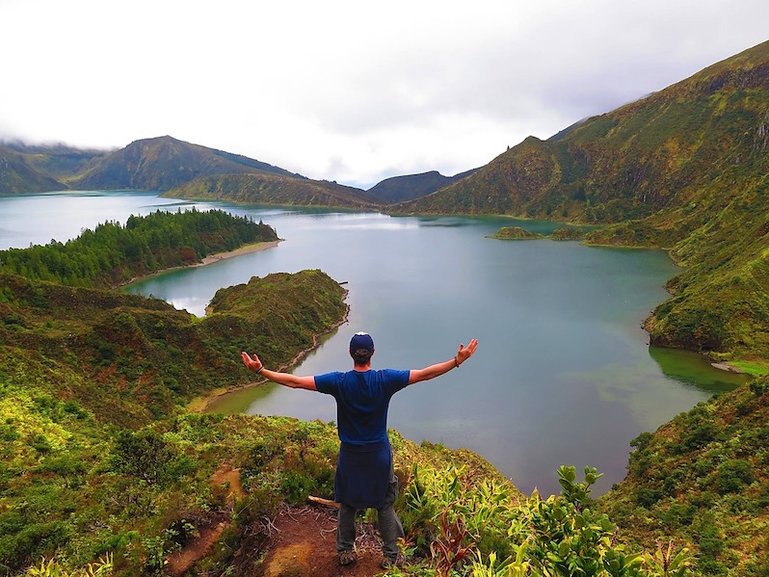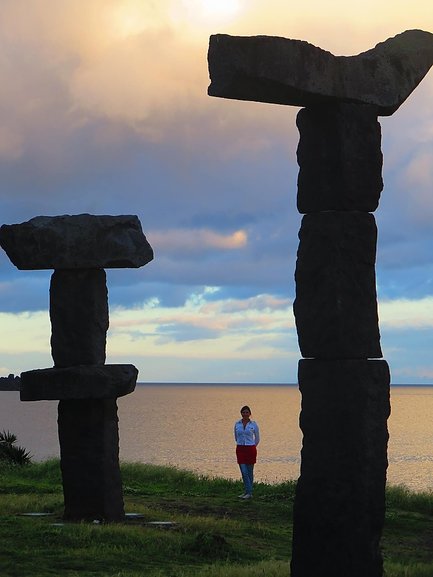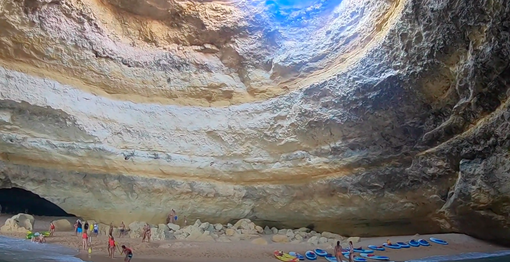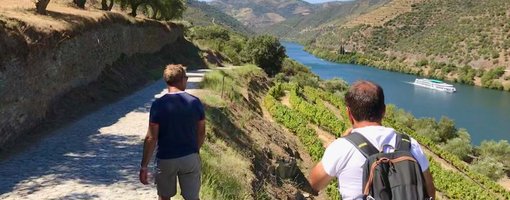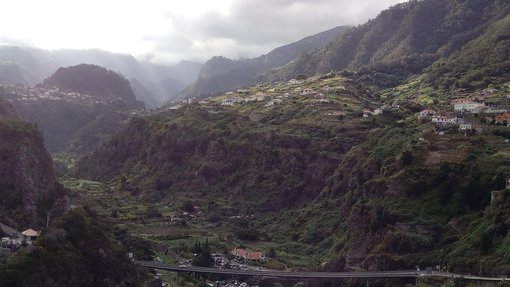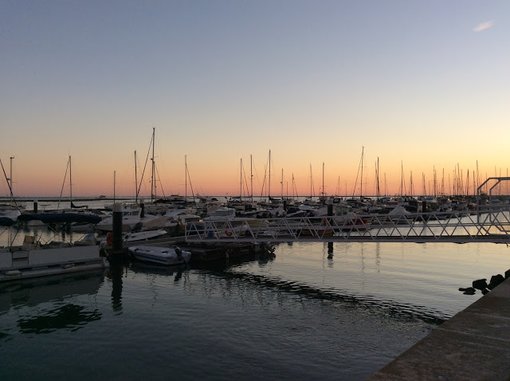This much nature is exhausting, but good for the soul. The compact archipelago of the Azores, specks of land in the middle of the Atlantic some 1,500km off the coast of Portugal, first appeared on our travelling radar a little over three years ago as we flipped through National Geographic’s ‘100 Journeys of a Lifetime’ coffee table book. There, whale-watching was highlighted, the author claiming the Azores to be a "marine paradise where the great mammals of the sea congregate all year round".
The Azores had got our attention, and as we researched more it held our attention…. and became a niggling itch that needed to be scratched until finally, fate had us living in Porto, Portugal, and within a direct 2.5 hour flight with Ryanair to the dramatic landscapes of this alluring and mysterious group of islands. We spent a week on the biggest of the islands, Sao Miguel, driving around and enjoying spectacular sea cliff views, natural pools, incredible crater lakes and endlessly rolling green hills.
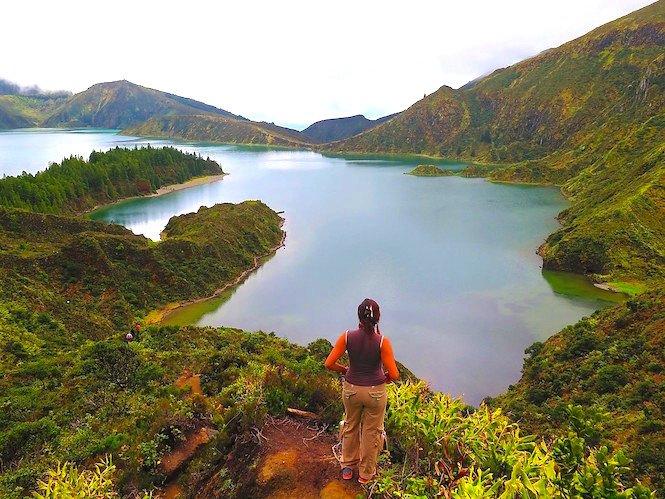
Lagoa do fogo
Day 1 – Ponta Delgada
We stayed in the VIP Executive for the first few nights, a short walk (downhill!) to the town of Ponta Delgada. Here, you can visit the 16th century Forte de Sao Bras de Ponta, now a military museum, spend time outside (and in) the gothicy Igreja Matriz de São Sebastião (Mother Church), and head down to the impressive three arches of the Portas da Cidade (Town Doors), built in 1783, and the lovely square…. and enjoy strolling around the pleasant little town with it’s cobbled streets and little cafes, lovely mansions…. for Ponta Delgada, the largest town in the Azores, enjoyed an economic boom in the 19th century, and the colonial and romantic architecture in the city is the evidence of this. It’s a small centre, and perfect for a stroll and a photoshoot. Ponta Delgada is pretty at night, too. The fountains glow, the Portas da Cidade are bathed in blues and greens…. it’s romantic. So much romance makes one hungry. Huddled in a corner on the chilly night we were there we saw a couple devouring some pretty incredible looking hot dogs. Looking around, we saw several more people sat at the roadside, on steps, hanging out of car windows, all eating the same thing. We followed our noses and came to the hot dog vendor…. and he was doing a roaring trade. 2 euros for a hotdog with trimmings that would even make a Venezuelan jealous. This guy puts olives in his pero calientes. We got one each, and joined the other happy souls in an Easter Friday worship of a different kind. Thirsty, we headed up a street and came across the rustic Cantinha dos Anjos, a popular bar with visiting navy vessels, of the flags scrawled with messages draped around the place are anything to go by. Other good evening options we found were 3 Sentidos pizzeria, and Raiz, a lively live music venue – we had a great time there dancing away and singing along to rock and pop and latin staples.
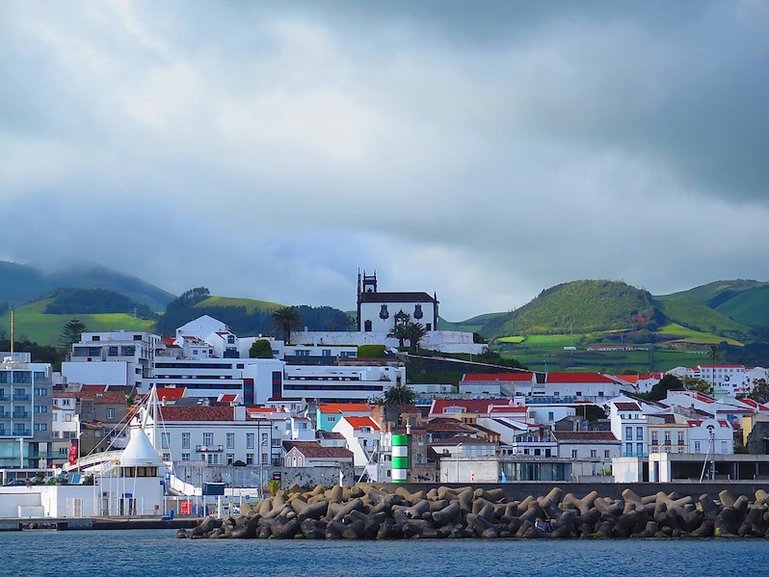
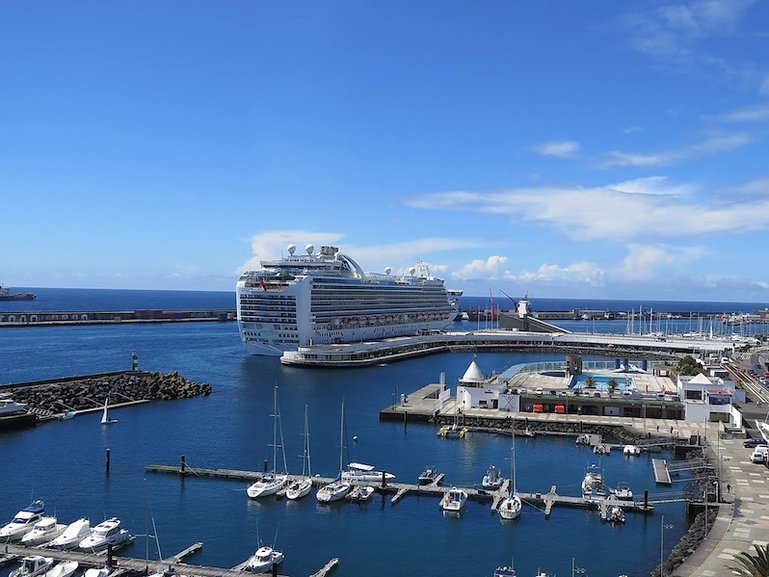
Day 2 – Lagoa Do Fojo and Caldeira Velha
We decided to have a go at getting to Lagoa Do Fojo ourselves, without needing to join a tour. We caught the 1:30 bus (actually, the buses in the Azores are all comfy coaches), to a place called Riberia Grande (2.95 euros each way), which is a fairly picturesque town located on the coast. The journey there took us past fields and fields and fields full of black and white cows – the Azores is famous for its meat and milk, and cows are more plentiful than people, apparently. From Ribeiro Grande we needed to get to Lagoa Do Fojo somehow, but there was no-one around. It was grey and wet. It was like a ghost town. Fortunately, in any town in Portugal where everything else is closed, you can always rely on the ‘Loja Chinesa’ (Chinese Shop) to be open, and the friendly lady who came from a small town in Eastern China helped us book a taxi, which cost a whopping 15 euros one way.
Lagoa do Fojo (Lake of Fire) is a stunning crater lake within the Agua de Pau stratovolcano, and surrounded by lush vegetation, with the Atlantic beyond…. it’s around 2.5 km in diameter, and as we walked down to the lake’s beach we were in awe of the blue and green transparent waters. It’s a very popular hiking trail, and I wished we had longer to explore, but at least we had time to reach the bottom and back before heading back. To see such natural beauty is exactly why we came to the Azores. Stunning.
We began walking down, until Veronica thankfully flagged down a car and we hitched with a father and son to another famous stop here, Caldeira Velha, hot springs in beautiful landscaped gardens, with different bathing pools at different temperatures, one with a pretty waterfall with the water cascading over rusty-coloured rocks due to the high mineral content of the water, and a visitors centre where you can get a lot of useful information. There are also changing rooms for those inclined to bathe. Veronica did, surprise surprise, Neil didn’t. There is also another pool, where the temperature is between 60 and 100 degrees celcius, so you could boil an egg in it, but wouldn’t want to jump in yourself. It was lovely, surrounded by tall trees, vegetation, the sound of the cascade.
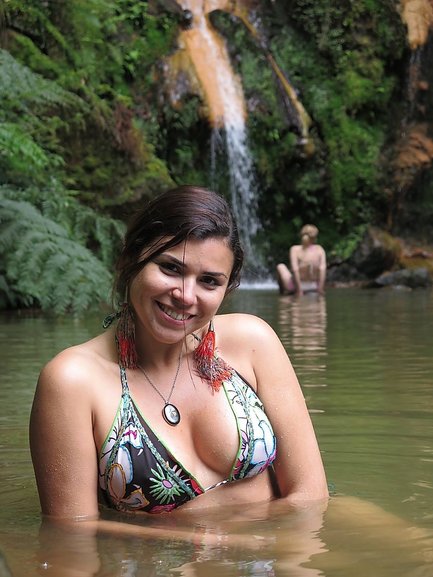
Caldeira Velha
Day 3 + 4 - Whale Watching
We’d earlier booked an afternoon trip on the ‘catamaran’ with the highly-regarded whale watching company ‘Futurismo’ for 55 euros per person. We were looking forward to this. April and May is the pinnacle of the migratory season for many species of whales, whose journey often takes them past Sao Miguel island. Around 27 species of whale can be found around the island, including Sperm Whales, Killer Whales, Pilot Whales, Humpback Whales, and even the largest animal that has ever lived, the Blue Whale. In addition, there are different species of dolphins and turtles that can be found, so we imagined the chances were good at seeing something. We had a good briefing from one of Futurismo’s marine biologists, who talked passionately about the different species we might encounter, and also the story of how the Azores successfully changed from whale hunting to whale watching, then we were shown to the boat and headed out to sea for three hours.
The ride out was incredibly choppy, and, as we were standing up at the bow, we were feeling every swell, and I almost surrendered my half-digested Delkabukes latte and croissant to the demanding sea on numerous occasions. Even worse is when the captain gets whale coordinates from the ‘whale spotters’ who work on land with powerful binoculars, and the boat picks up speed and changes direction so violently you’d be thrown over the side if you weren’t hanging on for dear life. I thought we were having a rollercoaster of a ride until I noticed the inflatable rafts full of tourists just behind us. For the same price, you can choose to board one of these, to get closer to the creatures. Not a wise choice today, and I could see the look of horror on the faces of the tourists, eyes wild with fear and mouths clamped shut as the dinghy went up and down at the mercy of the swells. Not a pleasant afternoon out at sea for them. The sun had disappeared behind rain clouds long ago and it was cold. It all seemed like a big waste of money and time until, finally, we were in luck. You know a whale is about when a huge jet of water sprays up. Not far behind that, you see the top of a head, the top of a shiny blue-black body, and you wait for the signature move, the huge tail to come up…. we saw everything but the tail when we spotted the first magnificent blue whale. The second lingered even longer at the surface, it’s body gliding softly through the water, but still no tail. Never mind. The biggest animal on the planet was just 30 metres from the boat. Incredible.
On the way back we were also lucky to see some common dolphins, and a loggerhead turtle, but the view of the island of Sao Miguel getting closer and closer was also impressive. We arrived back to the harbour fairly satisfied with the afternoon, and walked across to 3 Sentidos for a ‘four seasons pizza’…... and the sun had come out to play again. Life is good.
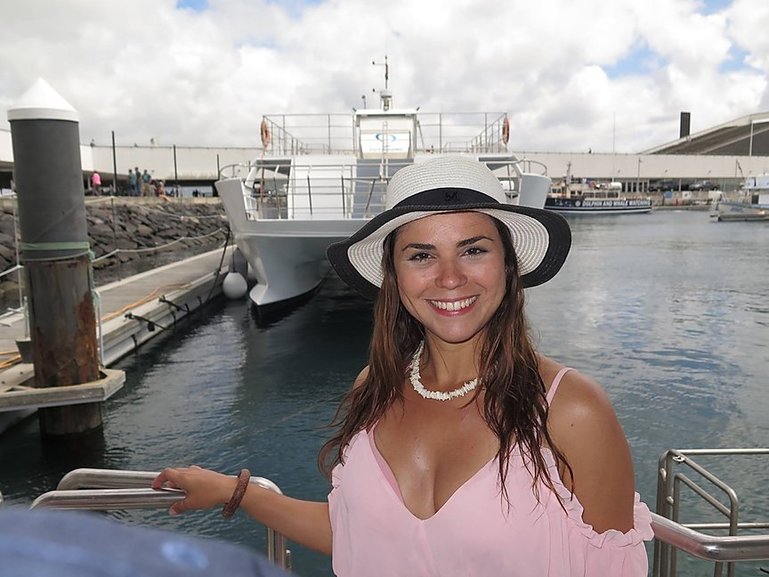
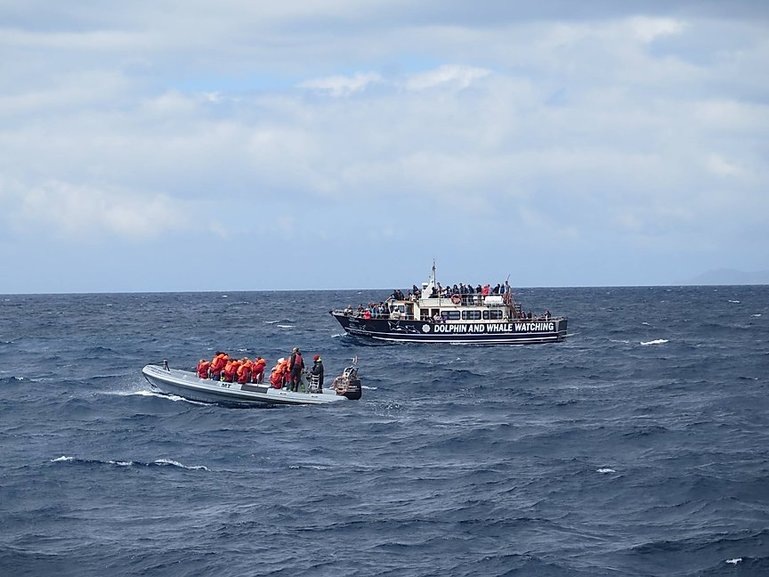
We collected the bags that we’d left at the VIP Executive hotel, and got a cab to Hotel Barracuda in Sao Roque, about a 10 minute ride from Ponta Delgada. We were glad of the move. Hotel Barracuda is right on a beautiful black sandy beach, all rooms are ocean facing, and it’s cheap. Our room had a small kitchen, and a large terrace to relax on. We were just in time for a walk on the beach to catch a lovely sunset, made all the more spectacular by the rain clouds. We had a beer and a snack in a cafe opposite the hotel, then relaxed on the terrace to the sound of the crashing waves. The Barracuda was a great find, and from here we were well positioned to explore the island for the next two days.
Day 5 – Sete Cidades, Mosteiros, Ferreira
The drive in our lovely little hired Smart car towards the famous Sete Cidades takes you along wonderful windy country roads, with several viewpoints, each more dramatic than the last. One in particular, stands out, and is the one that gives you the first complete view of these mystical and beautiful lakes. The Green and Blue Lakes, which according to legend, were formed from the tears of a shepherd and a princess who shared a forbidden love, are set in a crater some 5km in diameter. The surrounding greenery and blue sky frame the lakes beautifully, and we spent almost an hour at this viewpoint, in awe at the wonder of nature.
We drove down to the lakeside, to the green lake to begin with, and strolled around the lake’s edge, full of ducks and bullying geese who were chasing after the ducklings, people on leisurely boat rides, others paddleboarding…. it was a very pleasant place to while away some time, and we sat down and enjoyed our sandwiches taking in the peaceful scene. From here we drove to the Sete Cidades village, which has a pretty church, and stopped for a coffee and an ice cream at a local cafe, before we headed to the blue lake to take in the view. You can rent kayaks here to explore the lake, but we were content just to sit and soak in the day.
We drove down to the lakeside, to the green lake to begin with, and strolled around the lake’s edge, full of ducks and bullying geese who were chasing after the ducklings, people on leisurely boat rides, others paddleboarding…. it was a very pleasant place to while away some time, and we sat down and enjoyed our sandwiches taking in the peaceful scene. From here we drove to the Sete Cidades village, which has a pretty church, and stopped for a coffee and an ice cream at a local cafe, before we headed to the blue lake to take in the view. You can rent kayaks here to explore the lake, but we were content just to sit and soak in the day, before heading off to Mosteiros to see the spectacular cliffs and natural swimming pools.
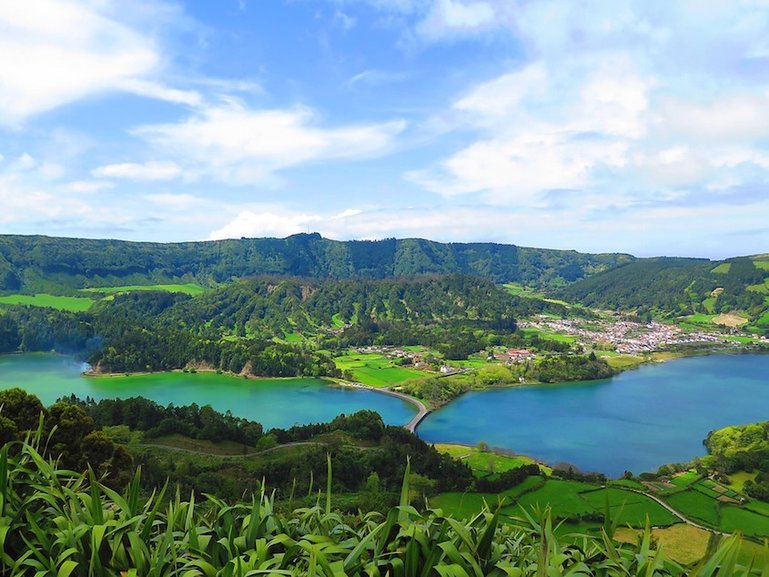
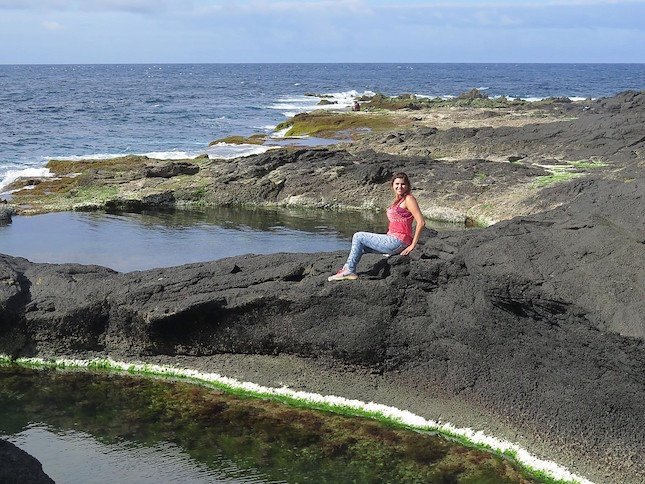
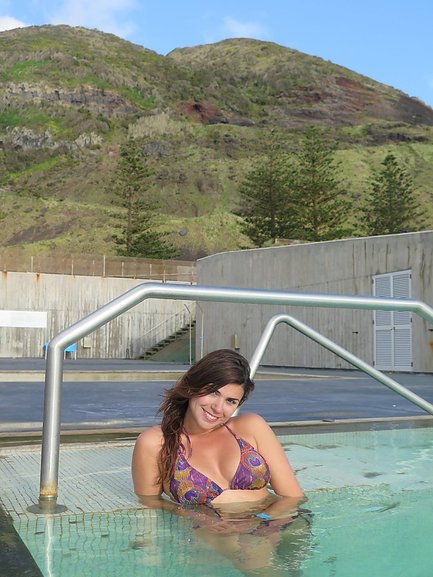
They say meat cooked under the earth tastes better. The meat stew (a delicious combination of pigs ears and chicken, with sliced cabbage and carrots thrown in for good measure), cooked underground for 7 hours using the natural heat from the volcanic earth, tastes slightly sulphurous (boiling pots are wrapped in cloth to keep the sulphuric steam locked in during cooking), but the tourists dig in like a pack of wolves, devouring the famed Cozido das Furnas at one of the specialty restaurants in the town. It’s just one of many things that Furnas is famous for.
Vero and I enjoyed the drive to Furnas. It’s a wonderful, hilly drive on the kind of empty, winding roads you see on car adverts, passing rolling green hills dotted with cows, and it boasts some wonderful vistas. We arrived at the Lagao do Furnas, and drove through a lovely wooded area full of picnic spots before coming to the parking area. Stepping outside the car was a bit like stepping into a roadside breakfast cafe full of the aroma of eggy farts. The sulphurous smell took a few minutes to get used to. We walked along a path through the woods and came out to the immense lake, the lake framed with vegetation, trees, and hills. To our right was a boardwalk, which took us on a short sightseeing tour of spitting, boiling, calderas, the earth angry; livid, and the steam rising menacingly from each volcanic vat. In one area set aside from the calderas, we saw the huge pots of Cozido das Furnas being hauled out of the ground by two men and loaded into the back of waiting vans, before being driven into town and served onto the plates of tourists looking for an authentic taste of Furnas. We wandered a little more, pausing to relax and take in the views, calm when you looked to the lake, tempestuous when you looked behind you.
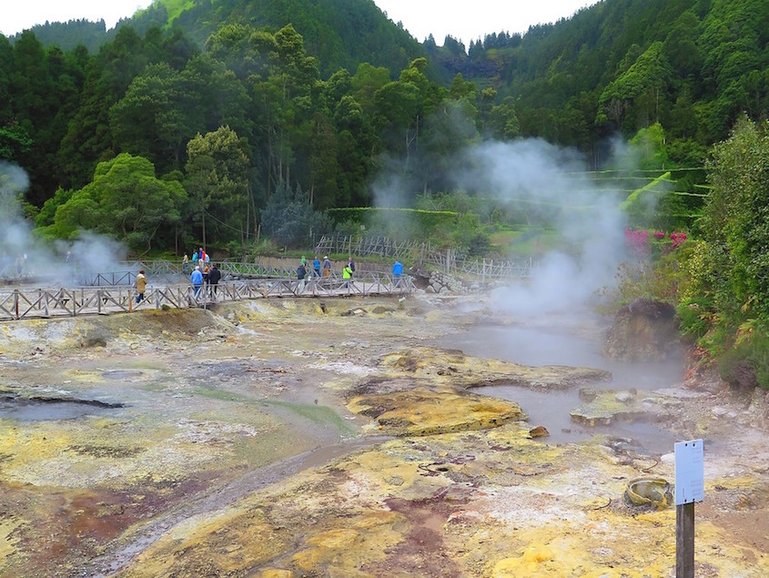
We drove from here through the village and parked outside the lovely Terra Nostra gardens. It was 8 euros to get in, so instead we went to the nearby Terra Nostra hotel to enjoy a delicious latte on the terrace overlooking the gardens. Refreshed, we walked into the village and found a bench in front of a church and nibbled our sandwiches which we had again made from what was on offer in the buffet breakfast. We decided to leave Furnas and go and find a cup of tea. But not just any tea.
Gorreana tea plantation is the oldest tea plantation on Europe. It’s also the only tea plantation in Europe. It’s been going since 1883, and still uses machines made back in the Industrial Revolution. It’s a small, family-run plantation, with many things still done by hand. Indeed, the small factory full of loud machines seems completely accessible to tourists, and I strolled around and witnessed first hand the labour intensive work that the small workforce puts in – the women rough and tough, the men rugged and unshaven, working with the old machinery in a loud, chaotic environment. I could almost taste the sweat in my first cup of black tea.
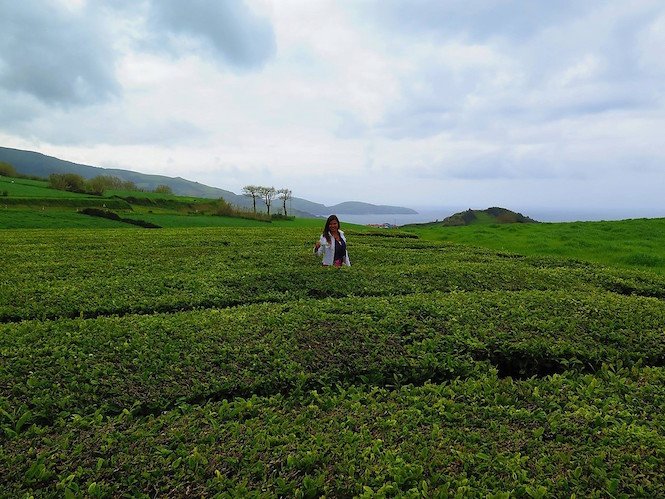
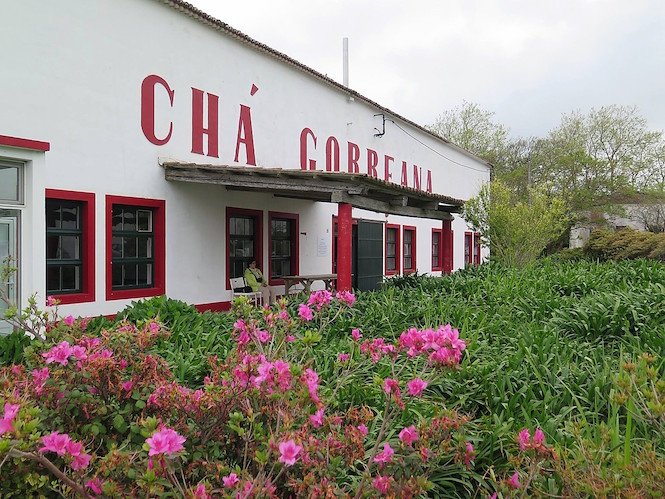
Outside are the plantations, small but beautiful with the Atlantic beyond them. We took a cup of tea from the cafe – the three types of tea produced here, black, green and oolong, are served free of charge – and we walked the tea plantations, taking deep breaths of fresh peaty air. Back in the cafe we had more tea…. for some reason tea on holiday always tastes so much better than my morning cup back home. Then we were off in search of more memories.
We headed to Ponta Formosa, the only white sand beach on the island, picturesque and popular with surfers. We drove past it once or twice, never made it in the end, and ended up on a beach called Moheina instead, a small stretch of black sand with towering cliffs to the left and right sheltering it. Not a soul on the beach, but there was a little cafe, which we popped into to get a refreshing Especial, ordering in our best Portuguese which was appreciated, with the waitress telling us upon learning where we were from how unfriendly and annoying the Spanish are – especially because they make no effort with Portuguese, apparently. Ah, the old Portuguese-Spanish rivalry…. I’ve heard that plenty of times on my travels in Portugal. The Portuguese would rather you speak in English to them than Spanish, and mixing Portuguese and Spanish is tolerated, but not recommended either. Still, Vero and I now have enough Portuguese to get by, and the overreactions of “Fala muito bem Portuguese! ” from shop assistants, baristas, waitresses and the other general positive reactions when we try the language are reward enough to continue. The effort is appreciated. We enjoyed our beers on the grassy terrace, smooth beach behind and then the sea cliffs. A quite dramatic setting, really. It was, we thought, the last stop of the day, night was falling.
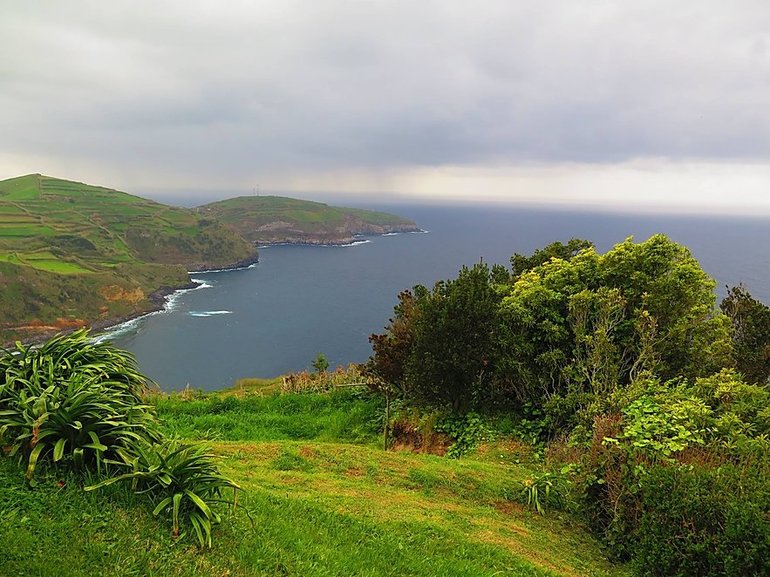
We got back in the car and navigated the steep and winding village streets until we came to a stretch of highway. Zooming back, we noticed signs to a Miradour, and pulled off to the side to enjoy one last sweeping, wind-swept vista – Miradouro Santa Iria. This was a spectacular viewpoint –lush and green landscape meeting the sea, and the cut of the coast visible for miles.
Back at the hotel we relaxed on the terrace with a small bottle of red wine and the sound of the sea. Hungry, we ventured out into the dark streets in front of the hotel. A 2 minute walk to the left brought us to Let’s Go! Mexican food – owned by a Portuguese guy and his Mexican wife who met at high school in California. We got chatting to them – both were typically Latin and friendly – they told us they loved living here in Azores, they love it because it’s safe, safe for them and safe for their children. The US just isn’t that for them. We had some excellent margaritas, and the food was excellent, as it must be when cooked by a real Mexican…. it was a marvellous meal, in marvellous company, to end a marvellous trip. The final night passed by to the sounds of the Atlantic just in front of the terrace once more…. lapping these rugged volcanic lands and their isolated people as they have done for God knows how long. This had been a special trip, and we had just explored one of the islands in this fascinating archipelago… there are many other islands to explore… we shall return, return for the landscapes, the thermal pools, the achingly beautiful and mystical lakes, the people, the whales…... the Delkabukes coffee.
This much nature is exhausting, but good for the soul.



